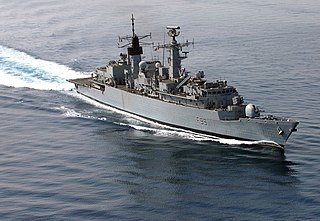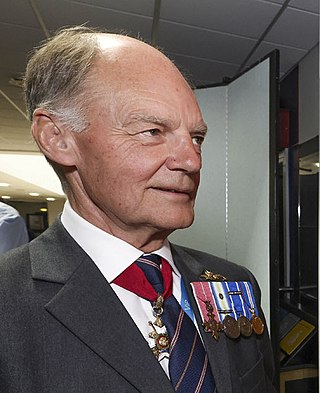
The Falkland Islands are a British overseas territory and, as such, rely on the United Kingdom for the guarantee of their security. The other UK territories in the South Atlantic, South Georgia and the South Sandwich Islands, fall under the protection of British Forces South Atlantic Islands (BFSAI), formerly known as British Forces Falkland Islands (BFFI), which includes commitments from the British Army, Royal Air Force and Royal Navy. They are headed by the Commander, British Forces South Atlantic Islands (CBFSAI), a brigadier-equivalent appointment that rotates among all three services.

The Fleet Air Arm (FAA) is the naval aviation component of the United Kingdom's Royal Navy (RN). The FAA is one of five RN fighting arms. As of 2023 it is a predominantly "rotary" force, with helicopters undertaking roles once performed by biplanes such as the Fairey Swordfish. It operates the F-35 Lightning II for maritime strike and the AW159 Wildcat and AW101 Merlin for commando and anti-submarine warfare.

HMS Cornwall was a Batch 3 Type 22 frigate of the Royal Navy. She was the first Batch 3 to be built, and the last to decommissioned. Cornwall was based at HMNB Devonport in Devon, England, part of the Devonport Flotilla.

HMS Argonaut (F56) was a Leander-class frigate that served with the Royal Navy from 1967 to 1993. She took part in the Falklands War in 1982, sustaining damage and casualties in action.

Vice Admiral Sir Timothy James Hamilton Laurence, is a retired Royal Navy officer and husband of Anne, Princess Royal, the only sister of King Charles III. Laurence was equerry to Queen Elizabeth II from 1986 to 1989.

Admiral of the Fleet John David Elliott Fieldhouse, Baron Fieldhouse, was a Royal Navy officer. He commanded five submarines and a frigate before achieving higher command from the 1970s. Following the invasion of the Falkland Islands by Argentine forces in April 1982, Fieldhouse was appointed Commander of the Task Force given responsibility for "Operation Corporate", the mission to recover the Falkland Islands. The campaign ended in the surrender of Argentine forces in June 1982. He became First Sea Lord and Chief of Naval Staff in December that year and, in that role, persuaded the British Government to fund the replacement of ships lost in the Falklands War. He went on to be Chief of the Defence Staff from 1985 until his retirement in 1988.

Admiral of the Fleet Sir Henry Conyers Leach, was a Royal Navy officer who, as First Sea Lord and Chief of the Naval Staff during the early 1980s, was instrumental in convincing the British prime minister, Margaret Thatcher, that retaking the Falkland Islands from Argentina was feasible. On account of the determination he showed in the matter, journalist and political commentator Andrew Marr described him as Thatcher's "knight in shining gold braid".
Admiral Sir William Richard Scott Thomas was the Gentleman Usher of the Black Rod in the British Parliament's House of Lords from January 1992 to 8 May 1995.

James Richard Dacres was an officer of the Royal Navy who saw service during the French Revolutionary and Napoleonic Wars, and the War of 1812. A member of a substantial naval dynasty, he eventually rose to the rank of vice admiral, but is chiefly remembered for his engagement with the American frigate USS Constitution which saw the loss of his ship, HMS Guerriere.

Admiral Sir Jonathon Band is a retired Royal Navy officer who was the First Sea Lord and Chief of the Naval Staff from 2006 to 2009. Before serving as First Sea Lord he was Commander-in-Chief Fleet. Since becoming First Sea Lord, Band had been a firm advocate of the creation of new ships to meet new threats and maintain the status of the Royal Navy as one of the world's leading naval forces.
Admiral Sir James Robert Drummond was a Royal Navy officer who commanded several ships in the Black Sea Fleet during the Crimean War and who commanded the Mediterranean Fleet from 1874 to 1877 before going on to be Fourth Naval Lord.
Rear Admiral Christopher Hugh Trevor Clayton, is a former Royal Navy officer who served as a Lynx helicopter pilot during the Falklands War. He went on to become a senior naval officer, commanding ships during the Hong Kong handover ceremony and 2003 invasion of Iraq and later serving high-level positions in NATO.
Admiral Sir Robert Laurie, 6th Baronet KCB was an officer of the Royal Navy who served during the French Revolutionary and Napoleonic Wars. He rose through the ranks after his entry, fighting as a lieutenant under Howe at the Glorious First of June, and being wounded in the action. Shortly after he served in the West Indies and off the American coast, where he operated successfully against enemy raiders and privateers, he was rewarded with the command of the frigate HMS Cleopatra, and in 1805 fought an action with a superior French opponent, Ville de Milan. He was forced to surrender his ship after several hours of fighting, but so heavily damaged the Frenchman that both she and the captured British vessel were taken shortly afterwards when another British frigate HMS Leander, arrived on the scene. Rewarded for his valour and honourably acquitted for the loss of his ship, he served throughout the rest of the Napoleonic Wars. He rose to flag rank after the end of the wars, eventually dying in 1848 with the rank of Admiral of the White. He inherited a baronetcy in 1804, but this became extinct upon his death.
Robert Lincoln Guy LVO was educated at Radley College and entered the Royal Navy in 1966. After training and subsequent service in two frigates, he was the ADC to The Governor of Gibraltar in 1972 and then commanded successively HMS Ashton and HMS Kedleston, both of the Fishery Protection Squadron. He qualified as a Warfare Officer in 1975 and then was the Operations Officer of HMS Arrow. Robert Guy was The Equerry to The Queen from 1977 to 1980.
Rear Admiral David Arthur Dunbar-Nasmith was a former Royal Navy officer who became Naval Secretary.

Admiral Sir Philip Andrew Jones, is a retired senior Royal Navy officer. After service in the South Atlantic in 1982 during the Falklands War, he commanded the frigates HMS Beaver and HMS Coventry. He went on to be Flag Officer, Scotland, Northern England and Northern Ireland, Commander United Kingdom Maritime Forces and Assistant Chief of the Naval Staff before being appointed Fleet Commander and Deputy Chief of the Naval Staff. Jones served as First Sea Lord from April 2016 to June 2019.
Captain David Hart Dyke is a retired Royal Navy officer, former aide-de-camp to Queen Elizabeth II, and former commanding officer of HMS Coventry, which was sunk during the Falklands War.

Vice Admiral Sir Timothy Pentreath McClement, is a former Royal Navy officer who served as Deputy Commander-in-Chief Fleet from 2004 to 2006.
Major General Charles Gerard Courtenay Vyvyan, is a retired British Army officer. He served as Head of the British Defence Staff and Defence Attaché in Washington, D.C. (1997–2000), and Gentleman Usher of the Scarlet Rod (2006–2018).
Air-Vice Marshal David Richard Hawkins, also known as David Hawkins-Leth, was a senior Royal Air Force officer who commanded the Royal Air Force Regiment in the 1990s. After his RAF service, he became an usher for Black Rod and a Deputy Lord Lieutenant for Greater London.











